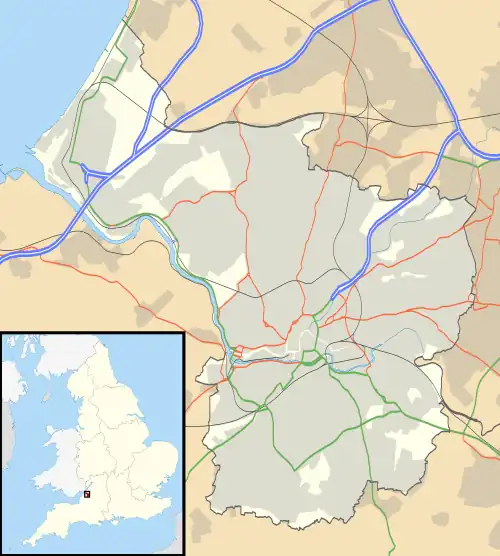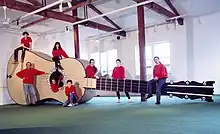Exploratory Hands-on Science Centre
The Exploratory Hands-on Science Centre was a science museum in Bristol, England. The project was conceived in 1981 by Richard Gregory CBE, professor of neuropsychology at Bristol University,[1][2][3][4][5] and was the first hands-on science museum in the United Kingdom.[6] It was inspired by the creation of the Exploratorium in San Francisco which had opened some years earlier and which appointed him Osher Visiting Fellow in 1989. Prof. Gregory said: "As I see it 'hands-on science' is to stimulate interest in science and technology by presenting phenomena and experiments to show how things work at first hand.."[7]
 Brunel's original Great Western station building (pictured in 1994), former home of the Exploratory | |
 Temple Meads, Bristol | |
| Established | 1987 |
|---|---|
| Dissolved | 14 September 1999 |
| Location | Bristol, England |
| Coordinates | 51.4489°N 2.5835°W |
| Type | Science museum |
| Visitors | 200,000 a year |
| Director | Iann Barron Executive trustee |
History
Initial funding for the idea came from the Nuffield Foundation and David Sainsbury through the Gatsby Charitable Foundation which he founded.[8] From 1987 to 1989 the interactive science exhibits were temporarily housed in the city's Victoria Rooms. In 1989 they moved to permanent installation at Bristol Temple Meads railway station. There, the expanded exhibition occupied two floors of the original terminal shed designed by Isambard Kingdom Brunel. The exhibits became known as 'plores' from the word 'explore', and the team of helpers in red sweatshirts were called 'pilots'. It was open seven days a week to the public and provided education programmes for school parties. Its footfall increased to more than 200,000 visitors a year with around 60% being children. The centre's aim of popularising science gained the active support of the TV astronomer Patrick Moore[9][10] In 1993 it hosted an exhibition from the popular BBC television series Doctor Who.[11] The space was also frequently used for broadcast of discussion shows about science for the BBC.[12]
The Exploratory closed in September 1999 when the lease on the building expired. Its successor was At-Bristol, now We the Curious, a larger science centre which opened in 2000 at a new site as part of the regeneration of the historic Floating Harbour.

One exhibit from the Exploratory, a giant Baroque guitar, was moved to the Deutsches Museum in Munich where it remains on public display.[13][14] The exhibit gained a place in the Guinness World Records in 1995.[15]
See also
References
- New Scientist. Reed Business Information. 1983. p. 484. ISSN 0262-4079.
- Barry Fox (23 December 1989). "Review of 'The Exploratory'". New Scientist.
- Braddick, Oliver (26 May 2010). "Richard Gregory obituary". The Guardian. Guardian News and Media. Retrieved 3 January 2011.
- "About". www.exploratory.org.uk. Retrieved 8 August 2016.
- "The Exploratory – History". www.exploratory.org.uk. Retrieved 24 December 2018.
- "The Exploratory - History". www.exploratory.org.uk. Retrieved 8 August 2016.
- Gregory, Richard. "Bristol Exploratory" (PDF). www.science-projects.org. Science Projects. Retrieved 17 May 2022.
- Gregory, Richard (2000). "Editorial". Perception. Pion. 29 (11): 1273–1278. doi:10.1068/p2911ed. PMID 11219984. S2CID 42898447.
- Thomas, Caroline (29 May 1993). "Patrick beats the drum for Hands-on science". Western Daily Press.
- Exploratory, The. "history". www.exploratory.org. The Exploratory. Retrieved 18 May 2022.
- Anon. "The Exploratory Exhibition in Bristol opened its doors in May 1993 providing some competition for the Longleat site". www.drwhoexhibitions.co.uk. Hyde Funsraisers. Retrieved 21 May 2022.
- Porter, Roy. "The exploratory. Pt. 4, The tomorrow people". www.wellcomecollection.org. Wellcome. Retrieved 17 May 2022.
- "The Exploratory - Exhibits". www.exploratory.org.uk. Retrieved 31 March 2021.
- Deutsches Museum. "Kids' Kingdom – a large Space for small Visitors". www.deutsches-museum.de. Deutsches Museum. Retrieved 21 May 2022.
- Guinness (1995). The New Guinness Book of World Records. Barcelona: Guinness Publishing Ltd. p. 147. ISBN 0-85112-736-3.